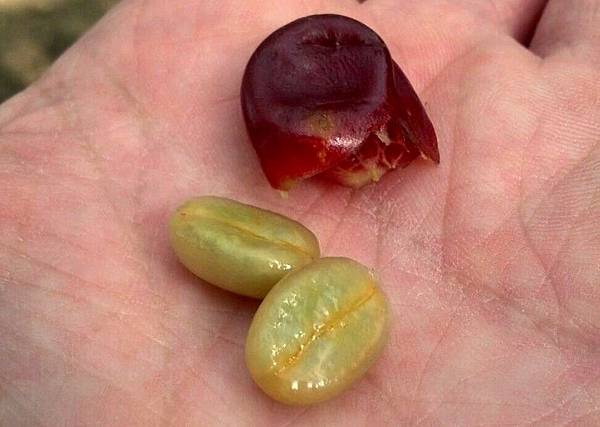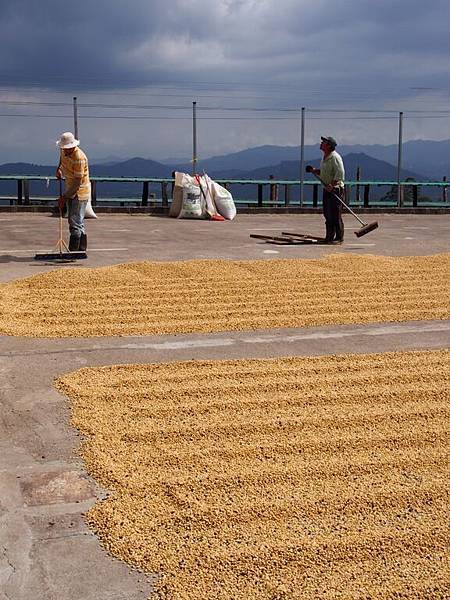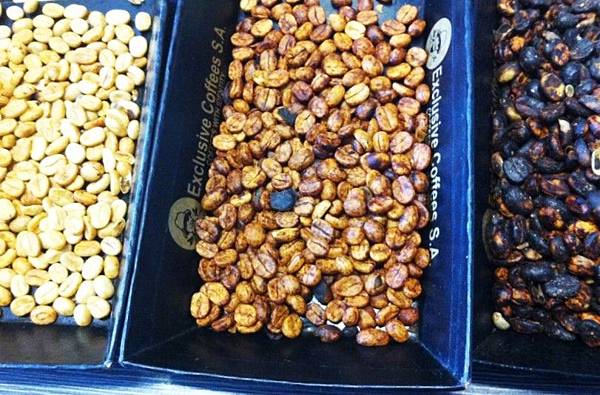關於咖啡蜜處理的兩三事…
圖文彙整/咖啡舖子Ryan Chien 2016/10/01

你曾好奇咖啡蜜處理是什麼嗎?
蜜處理咖啡比你先前喝過其他處理方式的咖啡好喝嗎?
以下這篇文章將引導你了解什麼是蜜處理?蜜處理有什麼特色?...
Why is Honey Called Honey?
為什麼要叫蜜處理?
咖啡主要的處理法有分三大類:日曬、水洗、蜜處理.
日曬法是在去除外殼及果膠層前直接曝曬咖啡果實;水洗法是以大量流動的水將咖啡果實的果皮及果肉泡軟(發酵)後剝除,然後進行曝曬乾燥篩除;蜜處理法則是介於日曬法及水洗法,將咖啡果皮剝除,保留果肉(果膠)層進行曝曬.
So, wait, where's the honey?
那你也許會問,蜜在哪?
蜜處理這個詞會讓許多人以為這個處理法是用蜜來處理咖啡,或是這種處理法的咖啡喝起來甜如蜜,但事實上都不正確的連結或解釋.蜜處理的意思來自於進行曝曬時咖啡果實的果肉(果膠)層黏膩感覺如蜜一般.也就是當咖啡果實剝除果皮後,外圍包覆著的果膠層經過曝曬,吸收空氣中的濕氣使果膠層變黏,好像裹著蜜般的狀態.

Why is Honey Processing Popular Among Farmers?
為什麼蜜處理大受咖啡農歡迎?
蜜處理一開始是有人看到用此種處理法能使他們的咖啡豆品質持續提升,源起於哥斯大黎加,而這個處理法現在正夯.
那為什麼哥斯大黎加的咖啡農一開始會打算用蜜處理?
當咖啡農想提升他們的咖啡品質或售價時,他們有三個選擇:改變咖啡的樹種、改變栽種海拔、改變處理法.就像大部分的人沖煮咖啡,會想用比較簡單的方式像是調整研磨刻度及粉量,再來才是調整咖啡機的水量、壓力和溫度;而大多數咖啡農也是想要先改變處理法,再來才會考慮栽種新樹種或遷莊園這種須投資較多時間與龐大金錢的方式.
So what's involved with honey processing?
蜜處理包含哪些步驟?
蜜處理法可不簡單, 既耗時又講究處理細節.
首先,咖啡農要從咖啡樹挑選成熟的咖啡櫻桃,再剝除外層的果皮,保留果膠層.果膠層保留了高比例的糖分及酸質,而這些甜分及酸質是蜜處理的關鍵.
接下來的步驟則是蜜處理最複雜最講究的地方:曝曬.
時間點必須掌握良好,時間長短是關鍵,曝曬時間如果太短,則無法轉換果膠層的物質到咖啡豆中,而時間也不能太長,動作必須要快以避免豆子內部過度發酵而成為發霉豆.
那要怎麼取得平衡呢?
將豆子放在日曬棚架或水泥地面上的前面幾天,每個小時都要翻動豆子數次直到達到保留期待的含水率,這個步驟通常需耗費6-10小時.之後的6-8天,每天至少需翻動一次.很耗時吧?蜜處理法的日曬之所以這麼耗時,是因為每天晚上豆子會吸收空氣中的濕氣,以至於隔天需要花更多時間來曝曬.
當咖啡曝曬完成後,就跟其他處理法一樣,可以進行乾燥處理以及烘焙了.

Why is Honey Processing So Wonderful?
蜜處理為什麼這麼美好?
當蜜處理這麼難做到好、又耗費時間,你可能會懷疑這一切真的值得嗎?
毫無疑問,非常值得.
蜜處理的咖啡一般會有很棒的甜味及平衡的果酸味,風味沒有日曬的咖啡濃烈,但卻更清新、香醇,何樂而不為?
這樣風味差異的關鍵來自於果膠層的糖分及酸質,在曝曬的期間,果膠層的糖分會越來越集中,而這些糖分會滲透到咖啡豆裡.
Yellow, Red, and Black Honey: What’s The Difference?
黃蜜、紅蜜、黑蜜的差別是什麼?
當你要購買蜜處理咖啡時,你通常會有黃蜜、紅蜜、黑蜜這些選擇,可能你也聽過這些蜜處理法分別保留果肉(果膠)層多少百分比,而這些究竟意味著什麼?
咖啡農會將咖啡做不同層度的處理,有些會保留較少的果肉(果膠)層,這樣可以縮短曝曬的時間;有些則會保留較多果肉(果膠)層,如此則需要更長的曝曬時間.黃蜜(大約保留25%的果膠層)在曝曬時為讓時間更快完成,必須要在最少遮蔽的環境(雲朵、遮蔭樹)進行,而獲得黃色的外觀.紅蜜(大約保留50%的果膠層)則會花費較長時間,需要一些遮蔽來曝曬.黑蜜(大約保留100%的果膠層)當然就需要更長的曝曬時間,過程中通常要覆蓋,以便延長曝曬的時間.

Yellow, Red, & Black Honey: Which Is Better?
黃蜜,紅蜜,黑蜜,哪一種比較好?
可能是黑蜜較佳,蜜處理的風味會因為果膠層含有的糖分帶來更細膩的影響,果膠層保留越多則風味越濃郁.(註:這是原文作者的觀點,咖啡舖子認為黑蜜,紅蜜,黃蜜等不同的處理方式會有不同的風味特色,哪一種比較好?端看個人的口味偏好.)
原文出處: http://www.perfectdailygrind.com/…/everything-you-need-to-…/

中文翻譯參考:Come True Coffee
《Everything You Need to Know About Honey Processing》
Have you ever picked up a pack of red honey processed beans and wondered what honey processing (let alone red honey processing)actually means? Or if it’s any better than the natural processed coffee you used last week?
This article is for you. We’re going to look at what honey processing is, why it’s good (most of the time), and what difference it makes to baristas and roasters.
Why is Honey Called Honey?
The three most popular methods of processing coffee around the world are natural, washed and honey. Natural processed coffees are dried inside the cherry before being hulled and milled. Washed (or wet) coffees are pulped and then fermented to remove the mesocarp (also known as mucilage) layer before being dried and milled. Honey processing bridges the gap between wet and natural coffees; the coffee cherry is pulped and then dried with the mucilage layer still left on the parchment.
So, wait, where’s the honey?
The title “honey processed” leads many people to assume honey’s used in the making of the coffee or that the coffee itself resembles honey tasting notes—but in reality, neither is true. This process gets its name from its sticky, honey-like feel the bean has before being dried. Once a coffee bean is separated from its cherry, it’s left covered in a mucilage layer that, when dried, will continue to reabsorb moisture from the air and become sticky.
Why is Honey Processing Popular Among Farmers?
Honey processing originally became popular in Costa Rica, who adopted it after seeing consistent improvements in the quality of their beans. Its popularity has since spread.
Yet why did Costa Rican farmers decide to try honey processing in the first place? Well, a farmer who wants to raise the quality (and subsequently the price) of their coffee really only has three options: they can change the tree varietal they grow, change the terroir, or change the processing method. And just as most of you would change the grind and dose of your grinder before you start adjusting volumetrics, pressure, or temperature of your machine, most farmers would rather experiment with processing before going to the extreme of moving their farm or investing in a new varietal that may take years to pay off.
Honey Processing: Long & Delicate Work
It’s not easy to honey process coffee. In fact, it takes a long time and you have to be very careful. So what’s involved with honey processing?
The first thing the farmers do is pick only the ripest cherries from the trees. The beans are then pulped from their outer skin, and as mentioned above, left in a layer of mucilage. This mucilage layer contains a high amount of sucrose (sugar) and acids which is really the key of the honey process.
The next stage is the most intricate and sensitive part of the process: the drying phase. You have to get the timing of this perfect. It’s crucial that you don’t dry the beans too quickly. If you do, the flavours won’t be converted from the mucilage to the bean. It’s also crucial that you don’t dry the beans too slowly. You need to be quick enough to avoid fermentation within the bean, otherwise you’ll end up with mouldy coffee.
So how do you reach this balance? Well, once either laid on raised drying beds or concrete slabs, the beans need to be raked or agitated multiple times each hour until they reach the desired moisture percentage. This usually takes between 6-10 hours. After that, the coffee needs to be agitated once a day for a minimum of 6-8 days. It’s long, right? Sun-drying honey processed beans takes this long because each night the beans pick up moisture from the air, requiring more drying the next day.
Once the coffee has finally dried, it’s ready to be dry milled and roasted just like with the other processes.
Why is Honey Processing So Wonderful?
When honey processing is so tricky to do right, and so time-consuming, you might wonder: Is it really worth it?
The answer: yes, unquestionably yes.
Honey processed coffees generally possess great sweetness and a balanced acidity with fruity undertones. The flavours are typically less powerful than natural processed coffee, but the clarity and definition of them is much clearer and more pronounced. Who doesn’t want that?
The key to this flavour difference is the sugars and acidity in the mucilage. Over the drying period, the sugars in the mucilage become more and more concentrated, and then these sugars begin to soak through to the coffee bean.
Yellow, Red, and Black Honey: What’s The Difference?
If you want to buy a honey processed coffee, you’ll find yourself presented with a choice: yellow, red, or black. You may also hear these described as a percentage. So what do these actually mean?
Well, farmers will often separate their crop into different categories. Some will have less mucilage, and therefore dry quicker. Others will have more mucilage, and will need a greater drying time. A yellow honey (approx. 25% mucilage) typically has the least cloud/shade cover during drying in order to speed up the drying time, and will gain a yellow colour. Red honey (approx. 50% mucilage) takes longer and is typically developed with cloud cover or shading. Black honey (approx. 100% mucilage) is usually covered so as to elongate the drying period.
Yellow, Red, & Black Honey: Which Is Better?
So which is better?
Well, it might seem that black is obviously better. The flavours of a honey process become more intricate and hold more depth relative to the amount of mucilage left on the parchment. The higher the mucilage, the stronger the flavours.
………



 留言列表
留言列表


